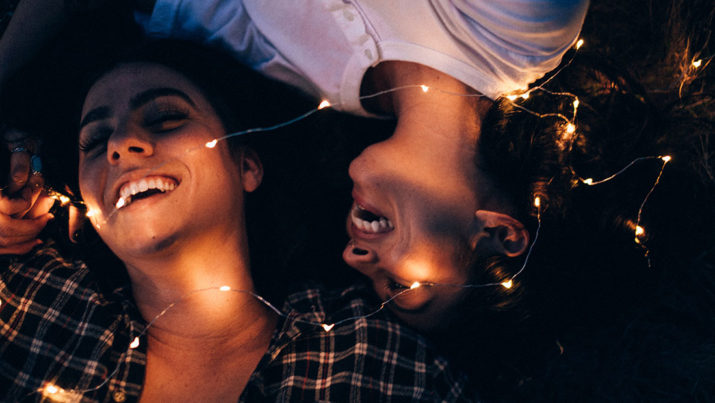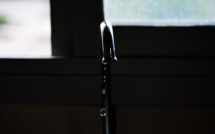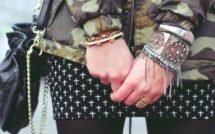
Years ago, a friend told me she’d kissed a girl. My first reaction? “Jealous!!!”
Wait, where did that come from?
A little personal reflection later, I concluded that having an experience with a woman like she had was something I was quite curious about. I had occasionally fantasized about it since my late teens, but never thought much of it. I had always accepted those thoughts as totally OK, but never contemplated action. Over the next couple years, while my friend was on an incredible coming out journey, I became even more intrigued. My depth of thought at the time was fairly basic: I was curious and wanted to experiment. No analysis, just curiosity. Easy!
My friend then moved to San Francisco, and I frequently visited her in what I felt was the most magical place on earth. She had come out, was having the time of her life, and had the most incredible and welcoming community of friends. I soon made a conscious decision to be open to experiencing in real life what I’d been so curious about for so long. The rest of the juicy details are orthogonal, but after that mindset shift, I started to have truly transformative and incredible relationships with women (and men). Accepting and exploring this part of me was critical in growing up, figuring out who I was, and learning about self-love and acceptance. Oh, and I permanently moved to the magical place that is San Francisco.
The truth is, I was insecure, too. I dealt with non-stop obsessive thoughts around trying to define “what I was”. I spent hours peeling back layers of uncertainty to try to get to a conclusion—one that never came.
Don’t get me wrong, it wasn’t a cake walk. Introducing my elderly grandparents to my first girlfriend was a challenge for them to wrap their heads around (bless their hearts for being incredibly open-minded) and a few of my closest friends had uncomfortable reactions. I was open about this new part of me with everyone I dated (it was new and really exciting!), and some of those folks were insecure about what they felt was a lack of commitment to one gender.
The truth is, I was insecure, too. I dealt with non-stop obsessive thoughts around trying to define “what I was”. I spent hours peeling back layers of uncertainty to try to get to a conclusion—one that never came. The ruminating started to take a toll on me and the people in my life who I confided in. A pivotal point for me was when a wise and more experienced friend, whose opinion I held in high regard, shared her own journey and taught me about the concept of sexual fluidity—that’s when things started to click. As a rationalist and often black and white thinker, the nebulousness of this concept was hard for me to wrap my head around. Ultimately though, I couldn’t argue her truth and the truths of other women I subsequently connected with that were having similar experiences. This concept was real.
While going through my own confusing and curiosity-laced time, it was these other women’s personal stories that helped me feel the most grounded and clear. I read a lot of articles, studies, and blog posts tackling the topic from a logical and scientific standpoint, but it was the empathy and honesty from women just like me that ultimately made me feel at peace.
When I think back, there are a few things that could have saved me some confusion, had someone told me sooner:
- What sexual fluidity is, by definition: “people’s sexual responses are not set in stone, and can change over time, often depending on the immediate situation they’re in. For example, if someone identifies as heterosexual but then finds themself in an environment with only people of the same gender, they might feel increased sexual/romantic attraction to those same-gender partners. Like any other social trait, sexual preferences, attitudes, behaviors, and identity can be flexible to some degree. Another related concept, erotic plasticity, is defined as change in people’s sexual expression (attitudes, preferences, behavior) due to socio-cultural factors and situational concerns. In other words, the basic idea is that someone’s sexual response can fluctuate depending on their surrounding environment.” (source)
- You’re not obligated to make a binary decision about your sexuality, ever.
- So many things about us change as we grow and journey through life—our preferences, style, interests, qualities we look for in partners—why would sexuality not fall into that list?
- Resist the urge to label yourself to people just to put them at ease, unless it’s a label you identify with.
- Resist the urge to respond to people who ask inappropriate questions. You don’t need to tell anyone about your sexual preferences. “I’d rather not share” is a great response that generally shuts down an inppropriate line of questioning.
- Some of your closest friends might be uncomfortable (even the ones you totally don’t expect it from) and that’s OK, it’s not indicative of how much they love you. People have deeply rooted biases that make can make it hard for them to digest something that seems different, or that they don’t know anything about.
- Do not apologize, ever. To anyone.
- Do not be afraid to share your journey with the people in your life, and try to normalize it when you do. Heading into a conversation with someone and framing it as this crazy thing that they might feel weird about is the wrong approach. Be unapologetic and honest while also being compassionate that they might have questions (which you may or may not want to answer), or need time to process.
- Be compassionate, but don’t take shit. If someone’s bigotry or implicit bias is so great that it becomes toxic, take your space. You don’t need to prove anything to anyone or dilute who you are to make others more comfortable.
- Be safe; sex ed applies regardless of gender.
- It is totally OK if you have no idea what you’re doing, you don’t need to pretend. Go with the flow and be transparent with a partner if something is new for you.
As we grow and change, I think it’s key to express gratitude, rather than fear, for new facets of ourselves that are coming into focus. Life is short, and if you’re curious about something, put a plan in motion to try it out! And don’t shy away from sharing your experience, you’re sure to find others who are on the same journey or have been there before.
Photo by Ashley Burnstad




